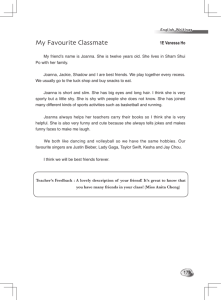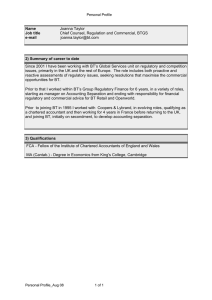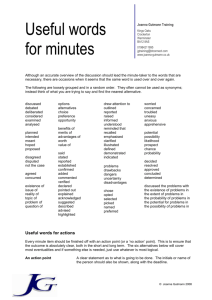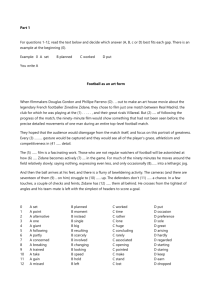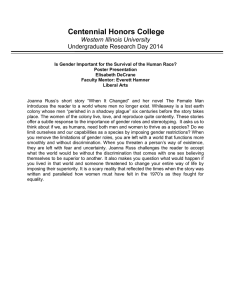Queen Joanna I: Power, Gender, and Madness in Spanish History
advertisement
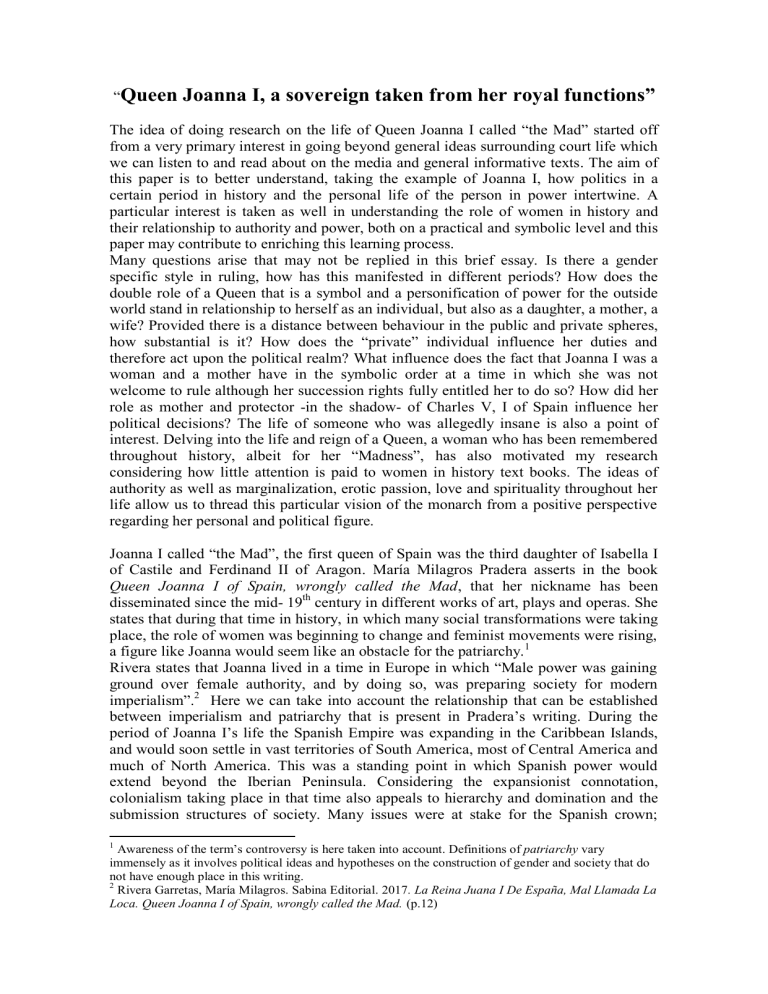
“Queen Joanna I, a sovereign taken from her royal functions” The idea of doing research on the life of Queen Joanna I called “the Mad” started off from a very primary interest in going beyond general ideas surrounding court life which we can listen to and read about on the media and general informative texts. The aim of this paper is to better understand, taking the example of Joanna I, how politics in a certain period in history and the personal life of the person in power intertwine. A particular interest is taken as well in understanding the role of women in history and their relationship to authority and power, both on a practical and symbolic level and this paper may contribute to enriching this learning process. Many questions arise that may not be replied in this brief essay. Is there a gender specific style in ruling, how has this manifested in different periods? How does the double role of a Queen that is a symbol and a personification of power for the outside world stand in relationship to herself as an individual, but also as a daughter, a mother, a wife? Provided there is a distance between behaviour in the public and private spheres, how substantial is it? How does the “private” individual influence her duties and therefore act upon the political realm? What influence does the fact that Joanna I was a woman and a mother have in the symbolic order at a time in which she was not welcome to rule although her succession rights fully entitled her to do so? How did her role as mother and protector -in the shadow- of Charles V, I of Spain influence her political decisions? The life of someone who was allegedly insane is also a point of interest. Delving into the life and reign of a Queen, a woman who has been remembered throughout history, albeit for her “Madness”, has also motivated my research considering how little attention is paid to women in history text books. The ideas of authority as well as marginalization, erotic passion, love and spirituality throughout her life allow us to thread this particular vision of the monarch from a positive perspective regarding her personal and political figure. Joanna I called “the Mad”, the first queen of Spain was the third daughter of Isabella I of Castile and Ferdinand II of Aragon. María Milagros Pradera asserts in the book Queen Joanna I of Spain, wrongly called the Mad, that her nickname has been disseminated since the mid- 19th century in different works of art, plays and operas. She states that during that time in history, in which many social transformations were taking place, the role of women was beginning to change and feminist movements were rising, a figure like Joanna would seem like an obstacle for the patriarchy. 1 Rivera states that Joanna lived in a time in Europe in which “Male power was gaining ground over female authority, and by doing so, was preparing society for modern imperialism”.2 Here we can take into account the relationship that can be established between imperialism and patriarchy that is present in Pradera’s writing. During the period of Joanna I’s life the Spanish Empire was expanding in the Caribbean Islands, and would soon settle in vast territories of South America, most of Central America and much of North America. This was a standing point in which Spanish power would extend beyond the Iberian Peninsula. Considering the expansionist connotation, colonialism taking place in that time also appeals to hierarchy and domination and the submission structures of society. Many issues were at stake for the Spanish crown; 1 Awareness of the term’s controversy is here taken into account. Definitions of patriarchy vary immensely as it involves political ideas and hypotheses on the construction of gender and society that do not have enough place in this writing. 2 Rivera Garretas, María Milagros. Sabina Editorial. 2017. La Reina Juana I De España, Mal Llamada La Loca. Queen Joanna I of Spain, wrongly called the Mad. (p.12) expansion of the Christian religion was one of them, and enhancement, as we have already mentioned, of the Spanish Monarchy. Consolidating its authority, the crown began to make up a new world order that evidently implied great benefits; the sought for goods and wealth at the expense of populations and cultures yet unknown to them, highlighed the hierarchy of the newly arrived over those populations. “A hierarchy involves graded ranks marked by differences in power and resources. Hierarchies are often shaped as pyramids, with small numbers near the top of the hierarchy, and large numbers at the bottom. [...] Society as a whole is hierarchically organized, or stratified: Almost all of the major systems of society politics, economics, religion, education, mass media, art and culture - which are hierarchically organized are male dominated.”3 Although the idea of society’s structures and their relationship with male domination should be approached with care due to its complexity, the ideas above help support Pradera’s thesis of Joanna I, woman that was in a position to embody an invulnerable empire, being affected by her male advisors taking over her duties and most of all, leaving her aside and consequently condemning her to isolation and public shame. In relationship to the signification of colonialism and top-bottom structures and submission, written from a more critical perspective the words of D. Sofia Maniscalco Mason relate to patriarchy in relationship to authority: “During colonialism, narratives of white supremacy were employed to justify the barbarity and immorality of European settlers. The cruel exploitation of the people of the majority world, and the theft of their natural resources, was re-inscribed as taking Christianity to “savages.” 4 Erotic passion Regarding other topics that surrounded Joanna I in her time was her diagnosis of having a highly strong erotic passion for her husband the Archduke Philip of Austria (14781506). Pradera also states that the legend of Joanna’s strong passion was created during the XVIth century possibly by Philip’s advisors in a context in which she inherited the throne of Castile and Aragon unexpectedly in 1503 after the death of her mother Queen Isabella I of Castile. She was pregnant to her fourth child and Philip was convinced he should inherit the throne, which Joanna did not accept which made the Archduke return to Flanders without his wife. Because disagreement between them was not convenient for the monarchy’s reputation, this falsified or exaggerated idea may then have then sustained the less agreeable facts that involved male domination (first her father and later it would be her own son, Charles I) over her inherited right to rule. Love In terms of Joanna I’s political resources it is interesting to note that she did not receive an education that would train a future queen, as she had two siblings before her that would inherit the throne. Public appearances and preparing speeches were not a part of her learnings and this meant that she had a disadvantage when exercising her power. On the other hand, Pradera confirms that she was familiar with different topics such as horse riding, clothing, health, fostering relationships and affections and argues that this would have been an important source for inner satisfaction and self-realization providing her with these soft and also necessary abilities for being. The author also 3 Moane G. (1999) Hierarchical Systems: Patriarchy and Colonialism. In: Gender and Colonialism. Palgrave Macmillan, London. https://doi.org/10.1057/9780230279377_2 4 Op cit. (p.24) mentions her closeness to ascetic Christianity that would also allow her to sustain herself when she was finally isolated in Tordesillas. Aram Bethany suggests in Juana the Mad: Sovereignty and Dynasty in Renaissance Europe that the queen’s decision to retreat close to the Clarisas in Tordesillas, as we will explain in the following lines, established a precedent that was followed by several of her descendants. Pradera mentions “obedience” to self as a characteristic that allowed her to remain strong during many years besides the injustices she had to face. Pradera suggests “she converted herself in living meditation”5 describing she was a bridge that would join her own potential of becoming queen to her mother’s own will, that was not fulfilled in life, of joining the crowns of Castile, Aragon, Navarre and Portugal. According to Pradera, Joanna I was aware of her own rights and those of her son Charles I born in 1500. He would inherit the throne in due time if his mother was alive. In order for her rights to remain intact she did not want to remarry. That is why she ordered her husband’s body to be exhumed from Miraflores’ Charterhouse (Burgos) and kept in the Royal Convent of Santa Clara right next to her palace in Tordesillas (Valladolid). In the time of Joanna I, one could not remarry until the deceased husband or wife was buried and so Joanna intended to bury her husband Philip’s body in Granada once her son Charles was old enough to reign with her, which is what finally occurred. Her father Ferdinand II, who wanted to take Joanna’s position as queen / king of Castile since the death of his wife Isabel I, tried in several occasions to prevent Joanna I from moving her husband’s corpse. He even tried unsuccessfully to have offspring with his following wife that would take Joanna’s throne he also kidnapped her son and took control over her household, her money and her carers and advisors with it. Joanna suffered from great pressure and her father, for fear of her death that would prevent him from his entitlement to govern Castile reached an agreement in which Joanna would remain in Tordesillas with the condition of keeping her husband’s corpse close to her in 1509. Philip called “the Handsome’s” corpse remained there until the year 1525. Far from necrophagic tendencies or an exaggerated passion for her husband, it seems as though self-preservation prevailed in Joanna’s action. Marginalization or retreat Joanna I stayed in the palace in Tordesillas during 40 years until her death in 1555. We include here an extract of a Speech given in Tordesillas to the “Comuneros” in Spain who revolted between 1520 and 1522 because they were unhappy with the instability that characterized the Spanish Monarchy seeing the weakness of Joanna I and of her son who had just come back from Flanders. This primary source may show to an extent how, not being able to emulate the type of leadership that she had not been brought up to exercise, she had an opportunity to deploy her own resources which involved “compassion, loyalty, symbolic independence, a sense of non-negotiable personal dignity and a spectacular gift for communication and performance”6: 24 de Septiembre de 1520 Yo tengo mucho amor a todas las gentes y pesaríame mucho de cualquier daño o mal que hayan recibido. Y porque siempre he tenido malas compañías y me han dicho 5 Rivera Garretas, María Milagros. Sabina Editorial. 2017. La Reina Juana I De España, Mal Llamada La Loca. Queen Joanna I of Spain, wrongly called the Mad. (p.52) 6 Rivera Garretas, M.M, (2017), La Reina Juana I De España, Mal Llamada La Loca. Queen Joanna I of Spain, wrongly called the Mad. Madrid, Spain, Sabina Editorial (p.30) falsedades y mentiras y me han traído en dobladuras, e yo quisiera estar en parte en donde pudiera entender en las cosas que en mí fuesen, pero como el Rey, mi señor, me puso aquí, no sé si a causa de aquella que entró en lugar de la Reina, mi señora, o por otras consideraciones que S.A. sabría, no he podido más. Y cuando yo supe de los extranjeros que entraron y estaban en Castilla, pesóme mucho dello, y pensé que venían a entender en algunas cosas que cumplían a mis hijos, y no fue así. Y maravíllome mucho de vosotros no haber tomado venganza de los que habían fecho mal, pues quienquiera lo pudiera, porque de todos lo bueno me place, y de lo malo me pesa. Si yo no me puse en ello fue porque ni allá ni acá no hiciesen mal a mis hijos, y no puedo creer que son idos. Y mirad si hay algunos dellos, aunque creo que ninguno se atreverá a hacer mal, siendo yo segunda o tercera propietaria y señora, y aun por esto no había de ser tratada así, pues bastaba ser hija de Rey y de Reina. Y mucho me huelgo con vosotros, porque entendáis en remediar las cosas mal hechas, y si no lo hiciéredes, cargue sobre vuestras conciencias. Yo así os las encargo sobrello. Y en lo que en mí fuere, yo entenderé en ello, así como en otros lugares donde fuere. Y si yo no pudiere entender en ello, será porque tengo que hacer algún día en sosegar mi corazón y esforzarme de la muerte del Rey, mi señor; y mientras yo tenga disposición para ello, entenderé en ello. Y porque no vengan aquí todos juntos, nombrad entre vosotros de los que estaís aquí, cuatro de los más sabios para esto que hablen conmigo, para entender en todo lo que conviene, y yo los oiré y hablaré con ellos, y entenderé en ello, cada vez que sea necesario, y haré todo lo que pudiere." (En: Nicomedes Sanz y Ruiz de la Peña, Doña Juana en Tordesillas, Valladolid, 1948, p.24)7 We can observe, from this speech the thoughtfulness and the complexity of her role as a ruler and the love she professes to her people and her inability to change what is not in her hands despite her willingness to do well. Her difficulty to rule was related to the boundaries that the established rules on who was allowed to rule in an ever growing and powerful empire in which a Queen could not take the head of on a practical level. Madness: “If Queen Joanna became ill it was because of fear, as proposed by historian Bethany Aram. Pradera suspects that the first written sources of her so-called mental illness appear only in 1503, which would denote some instrumentalization of her psychological state and therefore of her “doubtful” competences to rule”8. To finish, it would be highly interesting to become more familiar to the psychological implications of hierarchical systems for psychological development. Queen Joanna I, if she could speak would maybe be able to inform us with first hand information on how this took place in her life. The problematics of feminine sovereignty still remain a conflictive subject of which she is a victim but also an example of dignity that used the tools she had close to her to set an example for following generations. Questions of sanity and mental health can be interestingly analysed depending on which time in history they are considered. 7 8 Op cit. Rivera Garretas, M.M, (2017), (p.p 95-96) Op cit. Rivera Garretas, M.M, (2017), (p.18) BIBLIOGRAPHY Rivera Garretas, M.M, (2017), La Reina Juana I De España, Mal Llamada La Loca. Queen Joanna I of Spain, wrongly called the Mad. Madrid, España, Sabina Editorial. Aram, Bethany. La reina Juana. Gobierno, piedad y dinastía (Memorias y Biografías) (Spanish Edition) . Marcial Pons. Edición de Kindle. Aram, B. (1998), Juana "the Mad's" Signature: The Problem of Invoking Royal Authority, 1505- 1507. The Sixteenth Century Journal, 29(2), 331-358. doi:10.2307/2544520 Digital resources, articles, papers https://ceasefiremagazine.co.uk/war-if-you-want-it/ visited on January the 26th, 2020 1:43 a.m. Moane G. (1999) Hierarchical Systems: Patriarchy and Colonialism. In: Gender and Colonialism. Palgrave Macmillan, London. https://doi.org/10.1057/9780230279377_2
